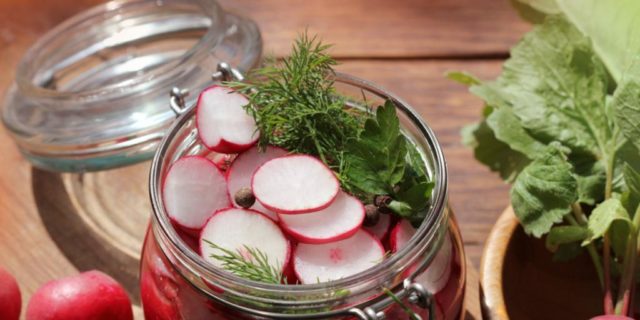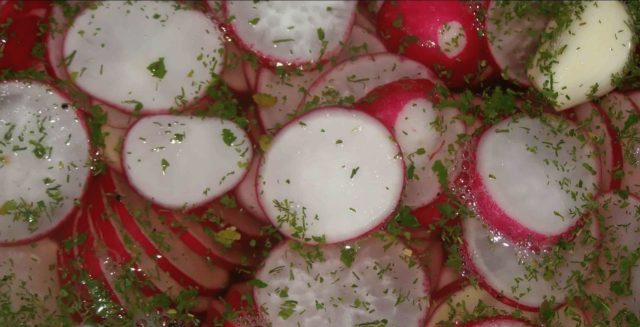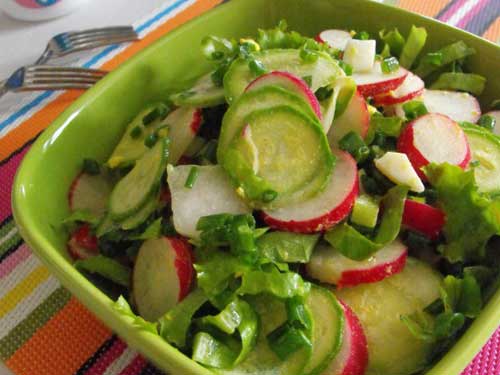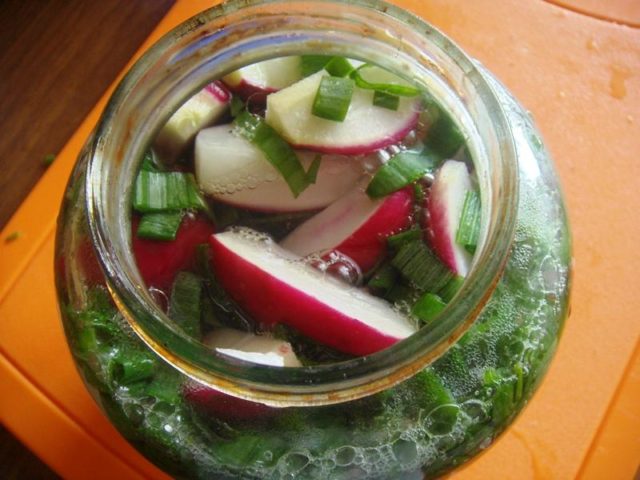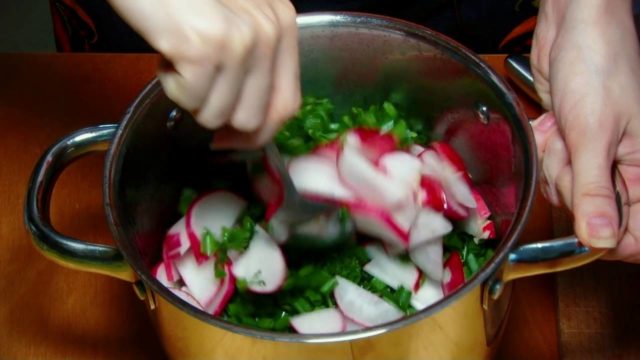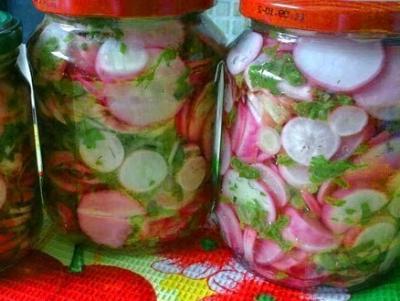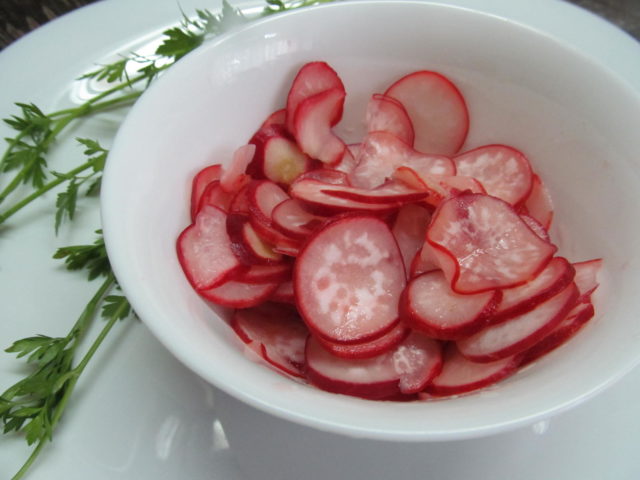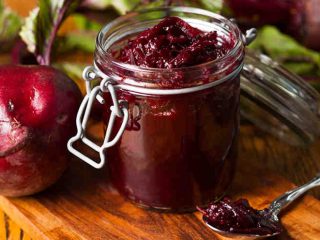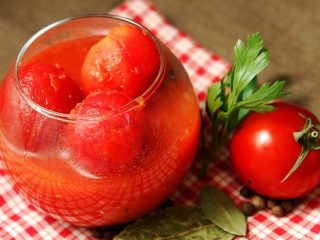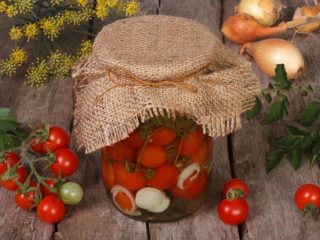Content
- 1 What can be cooked from radishes for the winter
- 2 How to make a radish salad for the winter
- 2.1 Delicious salad for the winter from radish with herbs
- 2.2 A simple recipe for radish and zucchini salad
- 2.3 Winter radish salad with cauliflower and garlic
- 2.4 Radish and currant salad recipe
- 2.5 Spicy radish salad for the winter
- 2.6 How to make a radish salad with coriander and garlic for the winter
- 3 How to properly preserve radishes
- 4 Salting radish for the winter
- 5 How to store radish blanks
- 6 Conclusion
Harvesting vegetables and fruits for the winter is a great way to preserve their beneficial properties for a long time. Radishes for the winter can be prepared in different ways. Combine with other ingredients to create a delicious dish that will delight your palate during the long winter months.
What can be cooked from radishes for the winter
Radish is one of the leaders in terms of the number of possible harvests. It perfectly tolerates the preservation process, retaining most of the nutrients for a long storage period. This vegetable is excellent for preparing a variety of salads. The root vegetable goes well with other vegetables. The addition of courgettes, onions or cabbage allows for a great flavor combination.
Salting remains the most popular cooking method. As an independent dish, and in combination with the classic version of the preparation - with cucumbers and tomatoes, the root vegetable will not get lost on the dining table. Experienced housewives have learned to ferment radishes in their own juice. The dish turns out to be unusual and very tasty.
How to make a radish salad for the winter
Salads with the addition of this root vegetable are appreciated for their special taste and benefits for the body in the winter months. To prepare them, it is important to be careful with your choice of ingredients. The basis of such salads is the radish itself. The fruit should be medium in size - not too large or too small. Large root crops have a hard skin, and small specimens are not yet ripe enough and have not accumulated the required amount of nutrients.
It is important to pay attention to the type of vegetable. The varieties that ripen in August or September are best suited. This allows you to be sure of the simultaneous ripening of other vegetables at the summer cottage. In addition, late varieties ripen longer, which means they accumulate more nutrients in themselves.
It is worth approaching with special care the choice of spices when cooking. Only on rare occasions does the addition of unconventional ingredients such as cardamom, cumin and red pepper pay off. The vegetable goes better with the common in Russian cuisine allspice, garlic and bay leaf. It is best to use regular table vinegar 6% or 9%.
Delicious salad for the winter from radish with herbs
This simple winter radish recipe is considered the traditional root vegetable harvesting method without adding a lot of additional ingredients. The greens in this case only preserve their vitamins and enhance the benefits of the salad in the winter months. For cooking you will need:
- 1 kg of fresh radish;
- a bunch of dill;
- green onions;
- a bunch of parsley;
- 4 cloves of garlic;
- 1 liter of water;
- 2 bay leaves;
- 2 tbsp. l. table or apple cider vinegar 9%;
- 2 tbsp. l. table salt;
- 5 peppercorns.
The vegetable is cut into thin slices and placed in pre-sterilized glass jars. It is important to remember the sequence - first a layer of radishes, then a layer of finely chopped herbs and garlic.In addition to parsley and dill, cilantro or other herbs are added to taste, depending on the chef's taste preferences.
Boil water in a small saucepan. Salt, bay leaves, vinegar and black pepper are added to it. The mixture is boiled for 3-4 minutes, removed from heat, cooled and poured into filled jars. Each of the cans is rolled up with a lid and sent for storage.
A simple recipe for radish and zucchini salad
In the marinating process, zucchini get a special taste that not everyone will like. However, they are extremely beneficial, therefore, should be present in the diet during winter and spring vitamin deficiency. For the recipe you need:
- 1 medium-sized zucchini;
- 0.5 kg of fresh radish;
- 4 cloves of garlic;
- 1 liter of clean water;
- 2 tbsp. l. Sahara;
- 1 tbsp. l. salt;
- 60 ml of 9% table vinegar;
- 2 bay leaves;
- 2 allspice peas.
First you need to prepare the marinade. To do this, vinegar and spices are added to boiling water, after which they are boiled for about 4 minutes. The radishes are cut in half, the zucchini are cut into slices. Vegetables are mixed and placed in glass jars, filled with brine. Banks roll up tight.
Winter radish salad with cauliflower and garlic
Cauliflower is a storehouse of elements and minerals useful for the body. It improves the functioning of the brain and circulatory system. In winter, such a salad is able to minimize the effects of a lack of vitamins. For 1 kg of fresh root vegetables, take 300-400 g of cauliflower and 5-6 small cloves of garlic.
The radish is cut in half, the cauliflower is disassembled into inflorescences, the garlic cloves are cut into 3-4 parts. All ingredients are mixed and placed in sterilized glass jars. Vegetables are poured with brine prepared at the rate of 2 tbsp. l. salt, sugar and 9% apple or wine vinegar, 2 bay leaves and a couple of peppercorns per liter of water. Banks are tightly closed and stored in a dark place.
Radish and currant salad recipe
The addition of currant juice gives the salad an unusual sourness and pleasant leaf aroma. Red currants are best suited for preservation. Since the berries ripen towards the end of summer, it is best to use late varieties. For cooking you need:
- 3 kg of fresh radish;
- 1 kg of onions;
- 500 g red currant;
- 2 liters of water;
- 2 tbsp. l. table vinegar 9%;
- 300 ml of vegetable oil;
- 10 peppercorns;
- currant leaves.
Onions can be placed whole in jars, but it is best to cut them in half. If the radish is too large, it can also be cut in half. At the bottom of each liter jar, put 3 tbsp. l. oil calcined in a pan. Then vegetables are put into the jars.
To prepare the marinade, you need to squeeze the juice from the currants. It is mixed with water and brought to a boil. Vinegar and black pepper are added to the slightly cooled liquid. Vegetables are poured with the prepared marinade. Lay out a few currant leaves on top. Banks are sterilized in boiling water and rolled up.
Spicy radish salad for the winter
Fans of savory dishes can prepare a spicy salad for themselves with the addition of hot pepper. Depending on your preferences, you can level the amount to get the desired pungency. For the recipe you need:
- 1.5 kg of radish;
- 6-8 hot pepper pods;
- a large bunch of green onions;
- a bunch of parsley;
- 150 ml of vegetable oil;
- 600 ml of water;
- 150 ml 6% vinegar;
- 10 allspice peas.
First, prepare the marinade. The water is brought to a boil, vinegar, allspice and salt are added to it. The mixture is boiled for 5 minutes and removed from heat.
The radish is cut into slices. Chives and parsley are finely chopped. Hot peppers are cut lengthwise, the seeds are removed from it and cut into pieces of 2-3 cm. At the bottom of each jar, add 2 tbsp. l. vegetable oil. Mix vegetables and herbs, then put them in sterilized jars and roll up.The finished salad is sent for storage in a cool place.
How to make a radish salad with coriander and garlic for the winter
Coriander adds indescribable aromatic notes to the dish. Such a salad in winter will become a real decoration of any table. For cooking you will need:
- 1 kg of radish;
- 1 head of garlic;
- a bunch of parsley;
- a bunch of green onions;
- 500 ml of water;
- 3 tbsp. l. 9% vinegar;
- 1 tbsp. l. ground coriander;
- 1 tbsp. l. sugar and table salt;
- 5 peppercorns.
Cut the radish into circles, add chopped garlic and finely chopped greens to it. The mixture of vegetables is laid out in pre-sterilized small jars and poured with prepared brine with the addition of coriander. Banks are rolled up tightly and placed in a dark, cool place.
How to properly preserve radishes
Unlike making salads, the rules applied to canning are slightly different. The main difference is that the roots are always added whole, without cutting them into pieces. The rest of the ingredients - onions, garlic and additional vegetables are also put whole.
It is important to understand that canned foods aim for a much longer shelf life. This is achieved by adding a stronger marinade. Instead of table vinegar, 9% vinegar is most often used vinegar essence. Black and allspice is also added 2 times more than in salad recipes.
Canned radish with cucumbers and tomatoes
Adding radishes to the classic pickled vegetables makes for a perfect assortment, from which everyone can choose their favorite ingredient during a big feast. The perfect harmony of flavors results in an excellent dish that will be appreciated by all family members in winter. For cooking you will need:
- 1 kg of fresh cucumbers;
- 1 kg of radish;
- 1 kg of tomatoes;
- a few sprigs of dill;
- a few currant leaves;
- 2 liters of clean water;
- 2 tsp vinegar essence;
- 2 cloves of garlic;
- 4 carnation buds;
- 16 peas of black and allspice;
- 4 tbsp. l. salt and sugar;
- 2 bay leaves.
Vegetables are thoroughly washed and placed in sterilized jars, filled with water. After 15 minutes, the water is poured into a saucepan, salt and sugar are added to it and brought to a boil. Spices, garlic, dill and currant leaves are added to jars of vegetables. All are poured with hot brine. Add 1 tsp to each jar. vinegar essence. After rolling, the vegetables are sent to a dark, cool place.
Canning lightly salted radish
Root vegetables are able to absorb the brine as quickly as possible, so a week after rolling under the lid, you can open the jar and enjoy a delicious dish. Of course, it is much more useful to do this in winter, when the lack of vitamins is felt more strongly, but you should not limit yourself in desires. For cooking you will need:
- 1 kg of radish;
- dill;
- 1 liter of water;
- 1 bay leaf;
- a couple of cloves of garlic;
- black peppercorns;
- 1 tsp vinegar essence;
- 1-2 tbsp. l. table salt.
Root vegetables are washed and put in jars without cutting them in half. Garlic cloves and dill sprigs are added to them. Vegetables are poured with brine prepared with the addition of salt and spices, then a little essence is added to each of the jars. Banks are tightly sealed and sent for storage.
Salting radish for the winter
Cooking vegetables for the winter by salting allows you to preserve nutrients for the longest possible time. Salt is a powerful natural preservative that destroys any bacteria. When salting radish, you can not worry about non-compliance with the amount of salt - the excess can always be washed off with water before use.
First you need to prepare a salt mixture.Traditionally, for 400-500 g of table salt, take a couple of cloves of garlic, a few feathers of green onions and 2 hot peppers. Vegetables are crushed into gruel and mixed until smooth.
Fresh vegetables are washed with cold water. Their tops and tails are cut off. If the roots are too large, they are cut into 2 parts. The radish is mixed with a salt mass, transferred to jars, corked with a lid and sent for storage.
How to store radish blanks
Like any other preservation, radish blanks are not very demanding on storage conditions, but simple recommendations are still worth following. The air temperature in the room where the jars are stored should be below room temperature. The ideal temperature is 6-10 degrees. A cellar or a well-insulated balcony is best suited for storage in winter.
As for the shelf life of the product, a lot depends directly on the marinade. For radish salads for the winter with a rather mild marinade, the shelf life will be up to one year. Canned vegetables with added essence can be stored for up to 3 years. As for salting - the shelf life of such a dish can easily exceed 2 years, however, over time, the taste and aroma of the product will decrease.
Conclusion
Radish for the winter is a real find for lovers of all kinds of conservation. A large number of cooking options will allow every housewife to find her perfect recipe for a dish. A long shelf life, subject to the correct canning technology, will allow you to delight yourself with vitamins during the long winter months.
